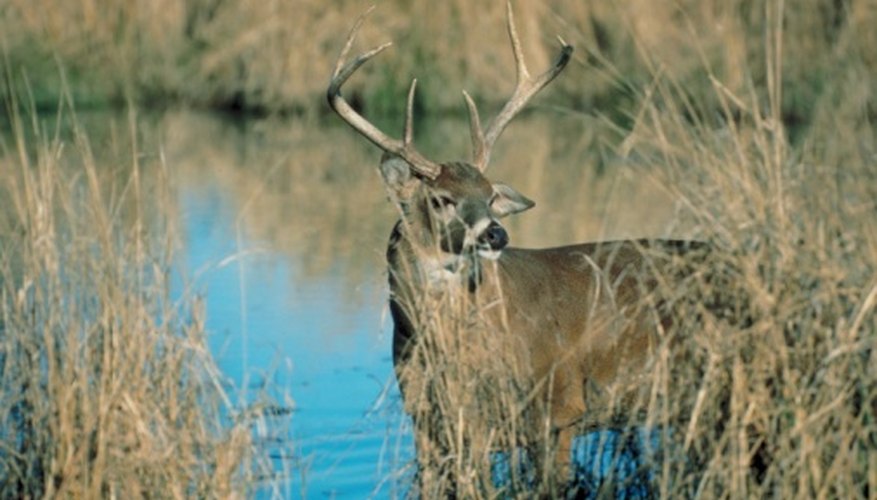
Preserving deer and other animal hides has been a part of human culture for centuries. The American Indians tanned and preserved hides as far back as their traditions go; even today hunters and others routinely tan and preserve deer and other hides. There are two basic preserving processes: salting and tanning. Neither process is terribly difficult, but each can be somewhat messy. Make certain that you have sufficient room and a well-ventilated area in which to work.
Salting a Hide
Split the hide down the belly of the deer so it lays completely flat. Use your sharp knife to do this. Lay the hide on a sheet of plywood or a large flat table with the flesh side up.
Scrape away any flesh that is still attached to the inside of the hide. Use the edge of your knife to scrape off the flesh, being careful not to scrape through the skin to the fur.
Trim any ragged edges using the tip of your sharp knife so the hide looks neat and clean all the way around.
Pour non-iodized salt onto the fleshy side of the hide, using one pound of salt for each pound of hide. Use your gloved hands to rub the salt into all parts of the hide, including tail and into any wrinkles. The salt will help to dry the hide and prevent deterioration. Leave the salted hide to air dry in a shady and protected area for three days.
Apply a second layer of salt after the first salting is three days old. Add more salt and work it into the skin with gloved hands, making certain that all parts of the pelt are salted.
Hang the hide or drape it over a clothes line after the second salting. Hang the hide with the salted side up so that all moisture drawn out of the hide by the salt can easily drain away. Disturb the salt as little as possible while hanging. Allow to hang in a shaded and protected area for 14 days.
Tanning a Hide
Deer hide
Sheet of plywood or large table
Sharp knife
Non-iodized salt
10-gallon plastic garbage can
Old hacksaw blade
Wooden stirring paddle
Baking soda or Borax
Two, 5-gallon plastic buckets
Ammonia alum or potash alum
Washing soda (crystallized sodium carbonate)
Cloths
Split the hide down the belly until it lies flat, skin side up. Scrape off any excess flesh and trim any rough edges.
Soak the skin in water for several hours until the skin becomes soft. Do not soak too long or the fur may start to fall out. Change the water every hour and begin inspecting the skin for softness starting after the second hour of soaking.
Lay the softened skin on a flat plywood board or large table, skin side up. Use the edge of a hacksaw blade to scrape the flesh side, removing any actual globs of flesh, and carefully scraping off the shiny layer under the flesh. Do not scrape any deeper than this, or expose the hair roots.
Fill your 10-gallon plastic trash can with warm water. Do not use metal, as this will react with the chemicals. Mix one ounce of baking soda or borax per gallon of water. Place your scraped hide into the solution and stir with a wooden paddle for 20 minutes.
Place the skin on a flat board or table, skin side up. Use your sharp knife, held nearly flat against the hide; scrape off any remaining flesh, dirt or debris. This portion of the process is called "scudding."
Fill your 10-gallon plastic trash can with warm water and immerse your scudded skin. Stir it with your paddle. Remove the skin from the water and hang it to drip dry. This will begin the tanning process of your deer hide with the fur still attached.
Dissolve 1 pound of ammonia alum or potash alum in 1 gallon of water in one of your 5-gallon plastic buckets. Check with your local pharmacy or farm supply store for ammonia alum or potash alum. Dissolve 4 oz. of washing soda and 8 oz. of non-iodized salt in 1/2 gallon of water in a separate 5-gallon bucket. Crystallized sodium carbonate (washing soda) is available in laundry section of most large supermarkets.
Pour the soda and salt solution very slowly into the alum solution while stirring vigorously. Pour slowly to keep the combined mixture from foaming over.
Soak your skin in this alum and salt solution for five days.
Rinse your hide in 5 gallons of water containing 5 oz. of borax. Rinse your hide in plain water. Lay the hide on a flat board or table. Press out most of the water with a flat edge or wadded up cloths.
Items you will need
References
Writer Bio
Larry Parr has been a full-time professional freelance writer for more than 30 years. For 25 years he wrote cartoons for television, everything from "Smurfs" to "Spider-Man." Today Parr train dogs and write articles on a variety of topics for websites worldwide.



